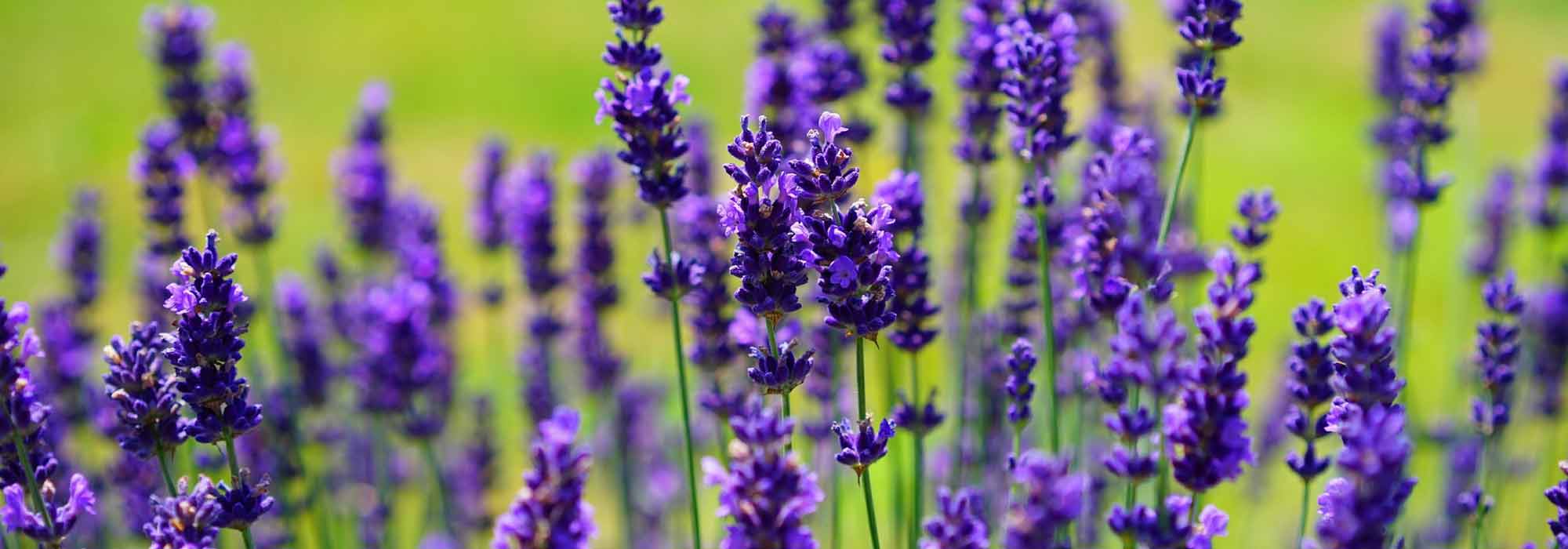
Lavender: planting, growing, pruning
Contents
Lavenders in a nutshell
- Lavender, with its unique aromatic scent, evokes summer and the Mediterranean
- It is an essential perennial shrub for the dry garden, featuring abundant summer flowering spikes in blue, violet, white, or pink, and is highly fragrant
- Hardy and undemanding, it is planted in full sun in very well-drained, stony soil
- Its evergreen foliage with silvery hues will brighten the garden, even in winter
- It is an iconic plant for rockeries, low flowering hedges, exotic flower beds, or sun-baked gravel gardens
A word from our expert
Lavender, lavandula in Latin, with its aromatic silver foliage and blue flower spikes, immediately evokes Provence and the sun of the Midi. Lavender flowers in purple, lilac, white, or pink emit a sweet and unforgettable fragrance, highly sought after in gardens as well as in perfumery.
The benefits of lavender are numerous and well-known in aromatherapy, particularly in the form of essential oils. Lavender combines therapeutic properties that are soothing and antiseptic with the pleasure of a fragrance that has been cherished since time immemorial.
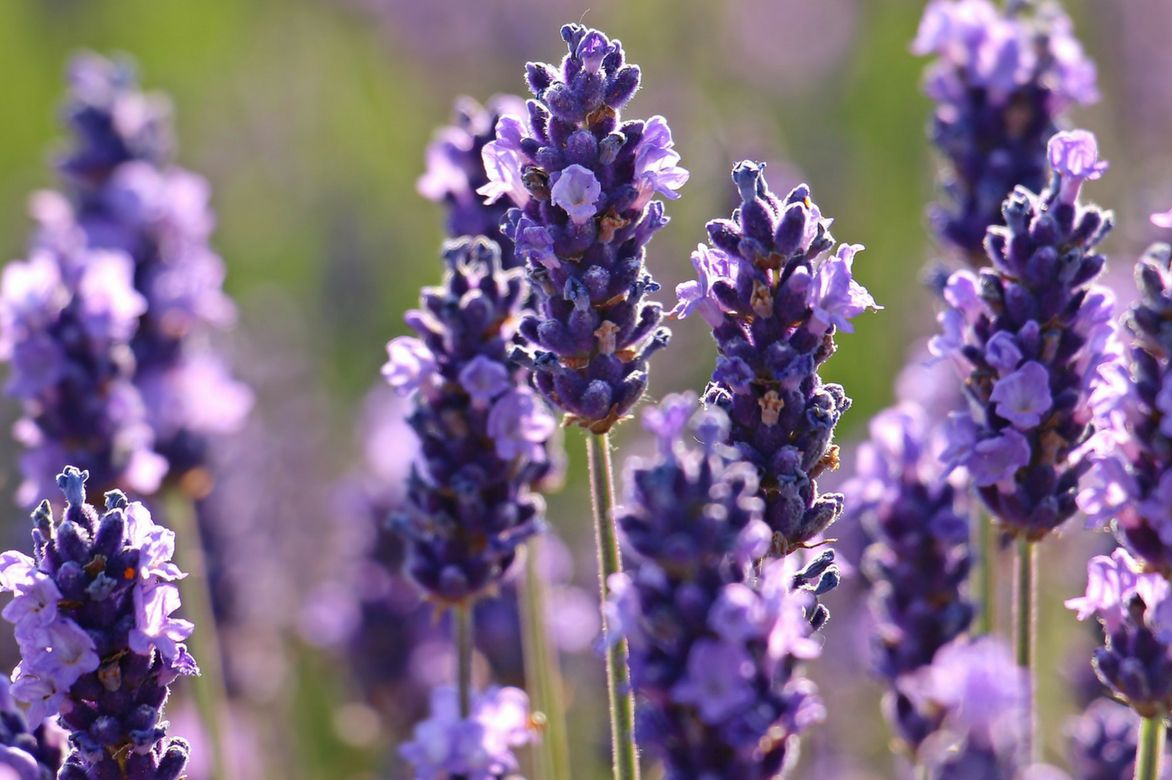
Lavender flowers.
Originating from Persia, the Mediterranean basin, and the Canary Islands, lavender is a mediterranean plant of exemplary undemanding nature, thriving in sun-baked, poor, well-drained soils, preferably calcareous: it has found its ideal habitat in Provence, where the arid climate enhances the quintessence of its character.
Despite its Mediterranean origins, this elegant shrub tolerates cold quite well (down to -15°-20°C) and grows throughout France where the soil is well-drained.
All in elegant simplicity, from April to October, depending on the varieties, clumps of lavender provide a colourful and fragrant punctuation in all gardens in perennial borders, isolated, edging, rock gardens, coastal areas, in a flowering low hedge, and even in pots on a south-facing terrace.
Its dried flowers will subtly scent your linen cupboards for a long time!
From Lavandin or Aspic lavender to “butterfly lavender,” and the true lavender, there is a lavender for every situation! Cultivation, care, planting, discover all our tips and choose the one you like from our collection of lavenders!
Description and Botany
Botanical data
- Latin name Lavandula
- Family Lamiaceae
- Common name Lavender, Lavandin, True Lavender, Butterfly Lavender
- Flowering from April-May to September
- Height 0.30 to 1.50 m
- Exposure Sun
- Soil type All, well-drained
- Hardiness -15°C-20°C depending on varieties
Belonging to the Lamiaceae family (formerly known as Labiatae), a cousin of sages, thymes, and rosemaries, lavender is an aromatic shrub native to the dry, sunny, and rocky regions of the Mediterranean basin extending to India and Southeast Asia. It grows wild in the foothills up to 800 m in altitude.
The genus Lavandula includes 28 species and numerous cultivars and hybrids. Lavandula angustifolia or Lavandula officinalis, sometimes referred to as True Lavender or “fine lavender,” can reach 1 m in height and has many cultivars such as ‘Hidcote’ with intense blue flowers, ‘Alba’ with white flowers, or ‘Rosea’ with pink flowers. The dentate lavender or English lavender (Lavandula dentata) with its dentate foliage, Lavandin (Lavandula (x) intermedia), “butterfly lavender” or “lavender with tuft” (Lavandula stoechas), are the most widespread and iconic varieties in our regions. The genus also includes Lavandula latifolia, also known as “Aspic lavender,” from which an essential oil is derived, ideal for insect bites!
This undershrub forms a compact and rounded clump with dense vegetation, reaching between 80 cm and 1.20 m in flower at maturity.
Growth is quite rapid; it takes about three years to obtain a generous and floriferous clump, but with good pruning, a lavender plant can live for 10 years.
The plant is characterised by a bushy habit, sometimes disorderly and ramified.
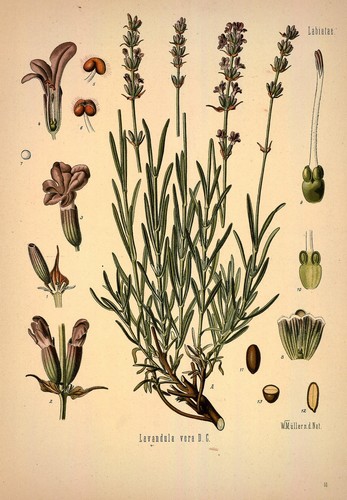
Lavandula – botanical illustration
The highly aromatic and evergreen foliage gives the plant a massive ball-like appearance. The sometimes quadrangular stems bear linear leaves that are opposite, simple, and entire or dentate, pinnate with edges rolled inward. Narrow, oblong to lanceolate, sometimes broader and rounded, they measure 2 to 8 cm long and are sometimes particularly woolly and downy.
Pale green to dark green, they mostly take on a lovely silvery-grey colour, especially pronounced in dry soil.
Lavandula intermedia (lavandin) is distinguished from “true” lavender (Lavandula angustifolia) by broader foliage, less silvery, and less fragrant.
Some (Lavandula intermedia ‘Walberton’s Silver Edge’) are distinguished by a unique variegated foliage of grey and white or cream yellow (‘Platinum Blonde’). In others, the silver-reflecting foliage sometimes takes on a purple hue in winter (‘Twickel Purple’). Others, like the dentate lavender, are characterised by fringed foliage, making them very easy to differentiate from other lavender species.
They emit a scent of pine or camphor when crushed.
This evergreen foliage with silver reflections will retain its appeal even in winter when the garden is at rest. From this round bush, long, fine, leafy stems emerge, sometimes branched, bearing numerous spikes of fragrant flowers that perfume the garden. The first early lavenders bloom as early as April (Lavandula stoechas), while others offer a rather late summer or even autumn flowering.
At the end of each stem, a narrow, dense spike forms, varying in length from 3 to 20 cm, bearing tiny flowers. Lavandula angustifolia (“true” lavender) is distinguished by a short floral spike.

Lavender flowers of different shapes and colours: Lavandula angustifolia ‘Alba’, Lavandula angustifolia ‘Superblue’, Lavandula stoechas, Lavandula angustifolia ‘Hidcote’ and Lavandula intermedia ‘Edelweiss’, Lavandula ‘Bandera Pink’.
The Lavandula stoechas bears the largest flowers of the genus and has a very particular flowering that earns it the names “lavender with tuft” or “butterfly lavender.” The flowers are gathered in spikes crowned with a tuft formed by several large petaloid bracts, resembling small raised wings.
Traditionally mauve or lilac in colour, the floral spikes are pure white in Lavandula angustifolia ‘Alba’ and Lavandula intermedia ‘Edelweiss’, dark violet in ‘Hidcote’, bright blue in ‘Munstead’, or lilac pink in ‘Rosea’.
The flowering is long, renewing itself in successive waves throughout the summer. At the end of flowering, its dry, fragrant, and colourful spikes will remain decorative for many months in the garden.
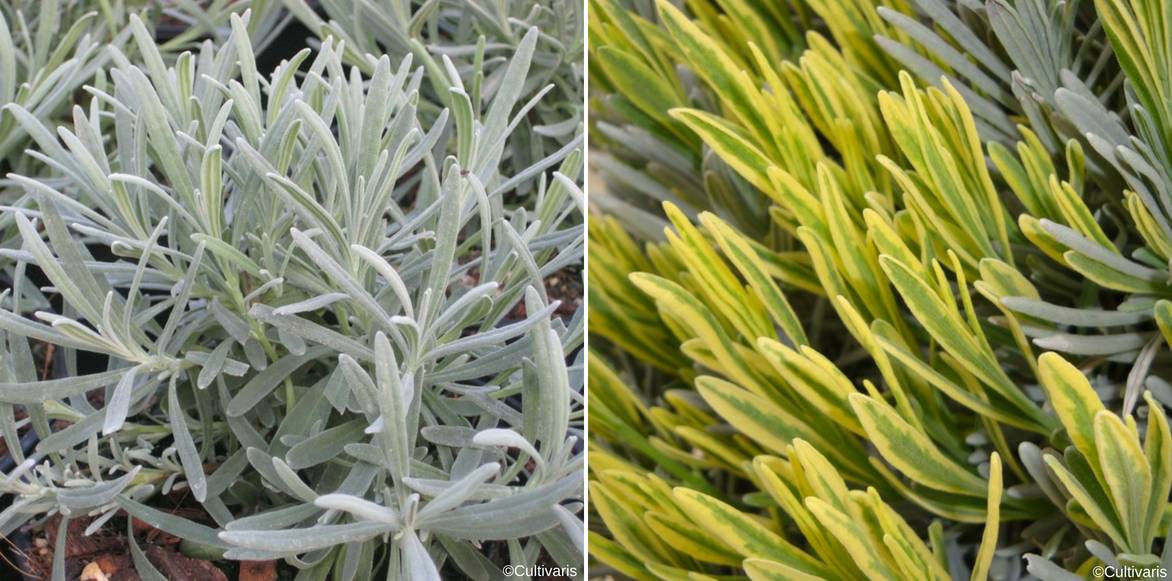
Lavender foliage: Lavandula ‘Phenomenal’ (Niko), Lavandula ‘Platinum Blonde’.
The harvest of lavender takes place in summer as the high temperatures promote the rise of the essence in the secretory glands of the flower.
The freshly bloomed spikes make very long-lasting dry bouquets, and the dried flowers and leaves of lavender placed in small sachets will perfume the cupboards.
In sunny and warm conditions, lavender flowers will exude an intense, herbaceous scent, fresh, with floral notes, unmistakable among all. This nectariferous and melliferous plant irresistibly attracts pollinating insects, particularly bees, which make its abundant nectar one of the most sought-after creamy honeys.
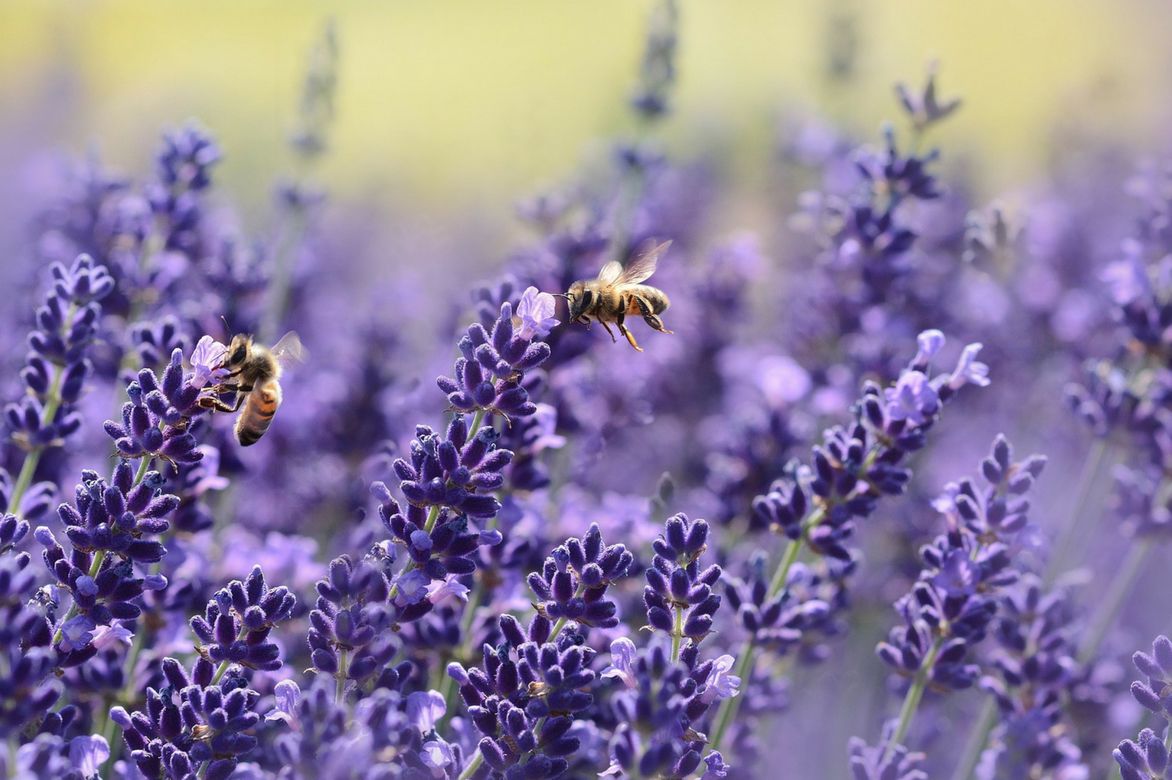
Lavender flowers are particularly melliferous.
Lavender is a Mediterranean plant that tolerates cold quite well. Fairly hardy (-15°C/-20°C for the less frost-sensitive), lavender can be grown in all our regions. In cold and humid areas, some, like Lavandula stoechas, which start to suffer from -5°C, will prefer to be grown in pots.
Lavender loves aridity. This dry-land plant grows in full sun, in any poor soil, preferably calcareous, even stony and gravelly, very well-drained.
Lavender integrates wonderfully into all gardens; it is equally at home in rockeries, as a specimen, in border plantings, and even in low flowering hedges, as well as in a lovely pot on the terrace.
Lavender has been known since ancient times for its fragrance, used notably in the form of essential oils. True lavender or fine lavender (Lavandula angustifolia) and lavandin (mainly used to scent soaps and laundry) are today the most cultivated species for their essential oil. The perfumeries of Grasse use fine lavender essential oil to create their precious “juices.”
In Provence, its flower is distilled to obtain an essential oil (fine lavender has its AOC designation “Essential Oil of Lavender from Haute Provence” since 1981), highly prized in perfumery and aromatherapy for its olfactory and medicinal virtues.
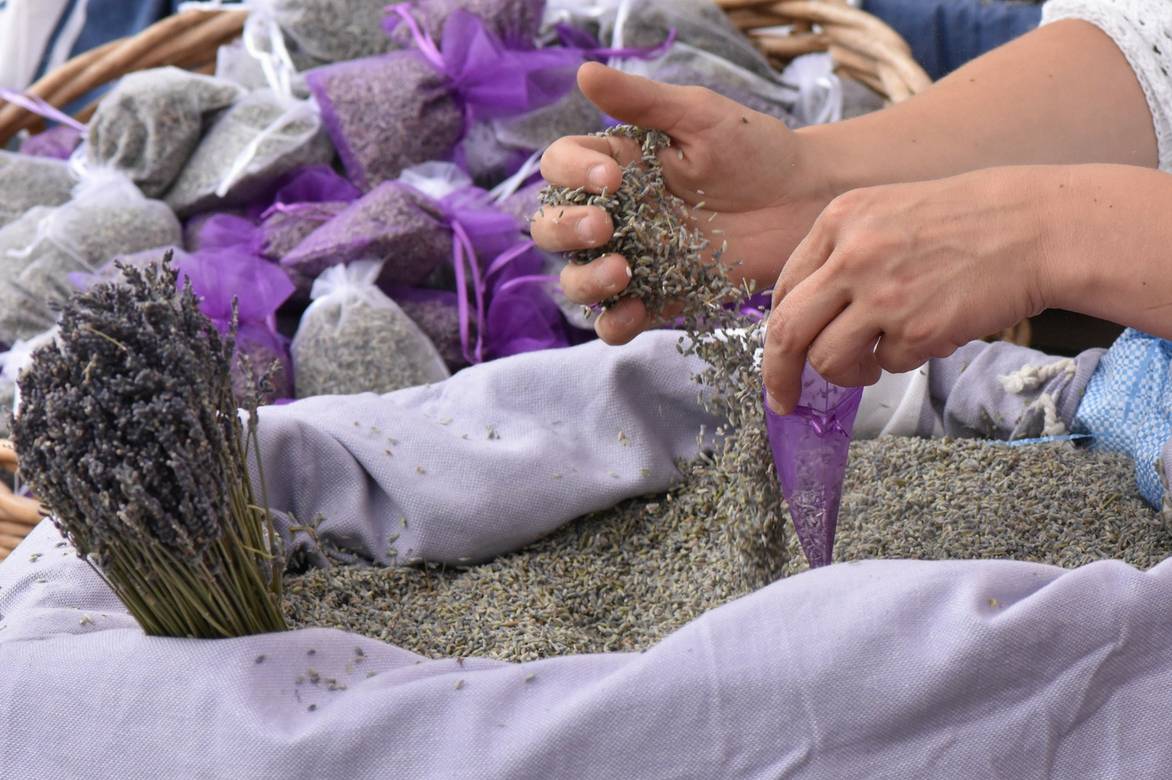
Making lavender sachets.
It has many therapeutic virtues: antiseptic, antispasmodic, healing, soothing…
It is also appreciated in cooking, where dried lavender flowers flavour sugar or summer fruit tarts.
There are “lavender routes” that traverse Haute-Provence. From June to August, the blooming lavender fields transform Haute-Provence into a purple ocean with an intoxicating fragrance.
Main species and varieties
On compte une vingtaine d species of lavenders, parmi lesquelles Lavandula angustifolia, true or fine lavender (and its numerous cultivars with white or pink flowers), Lavandula stoechas, the butterfly lavender, the most original of the lavenders and lavandin with a powerful camphor scent, are the most emblematic and commonly cultivated in our gardens. Sometimes, Lavandula dentata (English lavender) with its dentate foliage and Lavandula lanata or wooly lavender with leaves covered in a white down can also be found. Lavandula latifolia or “Aspic lavender” offers a later flowering and larger leaves than true lavender and is also more tender.
They are selected for their good resistance to cold and humidity which usually condemns these beautiful Mediterranean plants. They generally have a good hardiness (-15°C/-20°C) and are easy to grow in all our regions, only the butterfly lavender is a rather tender species that does not like lime and prefers slightly acidic soils unlike its more tolerant counterparts.
The choice is guided by the variety of flower colours: blue, purple, pink or white, by the size and volume of the plants. To learn more, we invite you to consult this article: Lavender: which one to choose?
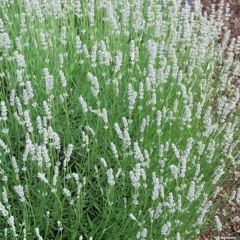
Lavandula intermedia Edelweiss - Lavandin
- Flowering time July to September
- Height at maturity 60 cm
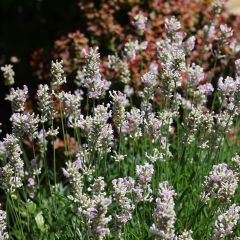
Lavandula angustifolila Rosea - True Lavender
- Flowering time July to September
- Height at maturity 60 cm
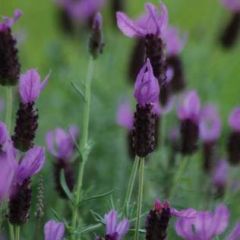
Lavandula stoechas - French Lavender
- Flowering time May to October
- Height at maturity 50 cm
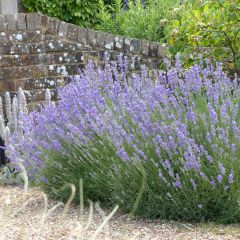
Lavandula angustifolia Munstead - True Lavender
- Flowering time August, September
- Height at maturity 50 cm
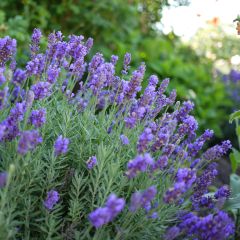
Lavandula intermedia Dutch Group - Lavandin
- Flowering time July to October
- Height at maturity 60 cm
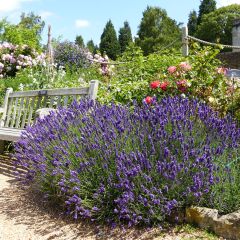
Lavandula angustifolia Hidcote - True Lavender
- Flowering time August, September
- Height at maturity 60 cm
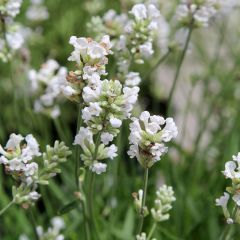
Lavandula angustifolia Alba - True Lavender
- Flowering time July to September
- Height at maturity 50 cm
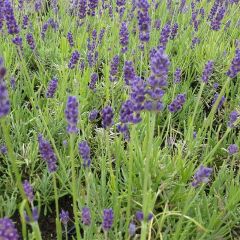
Lavandula angustifolia Twickel Purple - True Lavender
- Flowering time August, September
- Height at maturity 70 cm
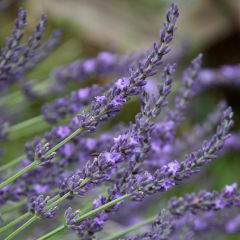
Lavandula intermedia Grosso - Lavandin
- Flowering time July to September
- Height at maturity 60 cm
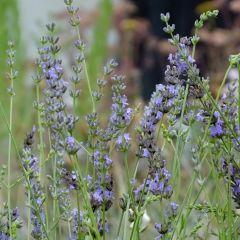
Lavandula intermedia Grappenhall - Lavandin
- Flowering time July to September
- Height at maturity 90 cm

Lavandula angustifolia Dwarf Blue - True Lavender
- Flowering time July, August
- Height at maturity 40 cm

Lavandula x chaytorae Richard Gray - Hybrid Lavender
- Flowering time July to September
- Height at maturity 40 cm

Lavandula intermedia Walburtons Silver Edge - Lavandin
- Flowering time August, September
- Height at maturity 60 cm
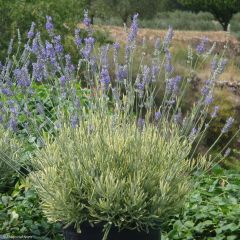
Lavandula intermedia Platinum Blonde - Lavandin
- Flowering time September to December
- Height at maturity 50 cm

Lavandula angustifolia Essence Purple - True Lavender
- Flowering time July to September
- Height at maturity 50 cm
Discover other Lavendula - Lavender
View all →Available in 2 sizes
Available in 4 sizes
Available in 2 sizes
Available in 0 sizes
Available in 0 sizes
Available in 3 sizes
Available in 3 sizes
Available in 1 sizes
Available in 6 sizes
Available in 4 sizes
Planting Lavender: in the garden and in pots
Where to plant Lavender?
Easy to grow, lavender, despite its Mediterranean origins, tolerates the cold quite well and thrives all over France. Depending on the varieties, lavender is more or less sensitive to frost. The hardiest lavenders, such as lavandin (Lavandula (x) intermedia), can withstand temperatures down to -20 °C, and most other lavenders easily tolerate down to -15 °C without issue.
Only the butterfly lavender (Lavandula stoechas) and its varieties are not very resistant to severe frosts (they may start to suffer at around -5 °C, with damage occurring at -8/-10 °C). It is advisable to grow them in raised beds, sheltered against a south-facing wall, and in pots to be wintered in colder regions.
Lavender loves heat and endures the long, arid summers characteristic of the Mediterranean climate without complaint. It prefers full sun and warm exposures, which will enhance the silvery colour of its foliage and intensify the strong fragrance of its flowers.
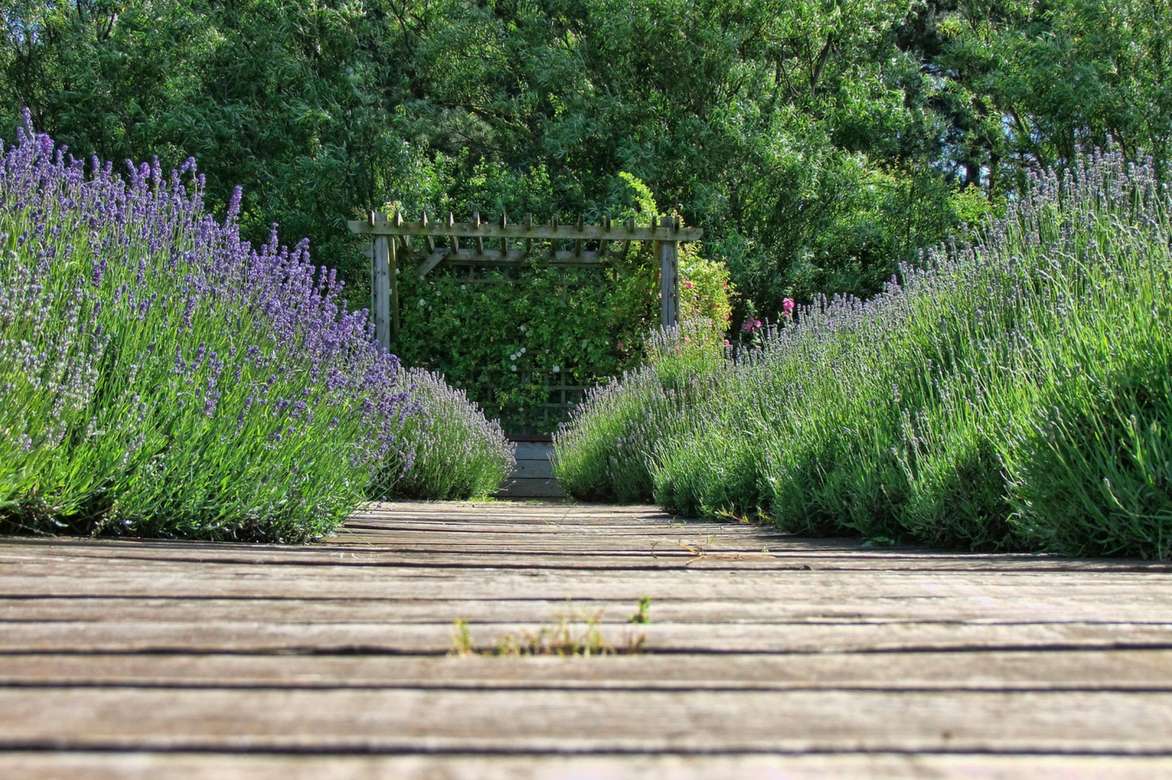
Lavender border.
This Mediterranean plant has retained a preference for very well-drained, poor, stony, dry, even arid soils. Lavender ages better in poor soil. It requires very well-drained soil. It thrives in any good light, well-drained garden soil, preferably calcareous (except for Lavandula stoechas, which prefers acidic soils).
Excess moisture and winter flooding are fatal to it: in overly wet soil, lavender can die within a few weeks. If your soil is too wet, plant it on a slope or in a rock garden.
Very versatile, lavender fits into all settings. Lavender is a boon for rock gardens, where it is ideal for forming large or small flowering borders all summer long, structuring a large rockery, or an exotic bed, or to occupy a bank or an ungrateful area of the garden.
Compact varieties with their spectacular bracts are perfect for borders, small rockeries, or in gravel.
The more opulent varieties are used in beds or in ribbons to form beautiful, well-defined low hedges along paths or as small separation hedges. Lavender can also be grown in pots, on the terrace or balcony, to be wintered out of frost in the cooler regions.
→ Ingrid explains how to Properly plant lavender in borders to structure your beds.
When to plant Lavenders?
Lavender is planted in spring in March or April when frosts are no longer a concern or in autumn in September-October in mild climates.
How to plant Lavender?
In the Ground
Lavender absolutely needs perfect drainage. In heavy or clayey soil, incorporate gravel or coarse sand at the bottom of the planting hole. Space the plants 40 to 60 cm apart (count 4 to 5 plants per m²). Don’t hesitate to mix lavenders together to have beautiful spikes in autumn and to play with the staggered flowering of different varieties: the first lavenders bloom as early as May.
- Soak the root ball in a bucket of water
- Dig a hole 4 to 5 times wider than the root ball
- Loosen the extracted soil well
- Untangle and lightly rake the root mass
- Spread a layer of gravel at the bottom of the hole
- Place the root ball in the middle of the hole, burying the collar well
- Fill the hole and then lightly compact
- Water at planting, then moderately without flooding the roots
Lavender in pots
The substrate must be very well-drained to avoid stagnant moisture and root rot. Place it in full sun. It is an undemanding plant! Soil that is too clayey will be detrimental: improve drainage with gravel, coarse sand, or a mix of pebbles…
For Lavandula stoechas, which is more acidophilous, add a third of heather soil to acidify the substrate and only water with non-calcareous water.
Many dwarf varieties are perfectly suited for pot cultivation.
- In a large terracotta pot of at least 50 cm in diameter, spread a good layer of drainage (gravel or clay balls)
- Plant your lavender in a mix of garden soil or potting soil for Mediterranean plants and coarse river sand or pumice
- Water at planting, then without excess
- In cold regions, store the pot for winter and bring it out as soon as the good weather returns
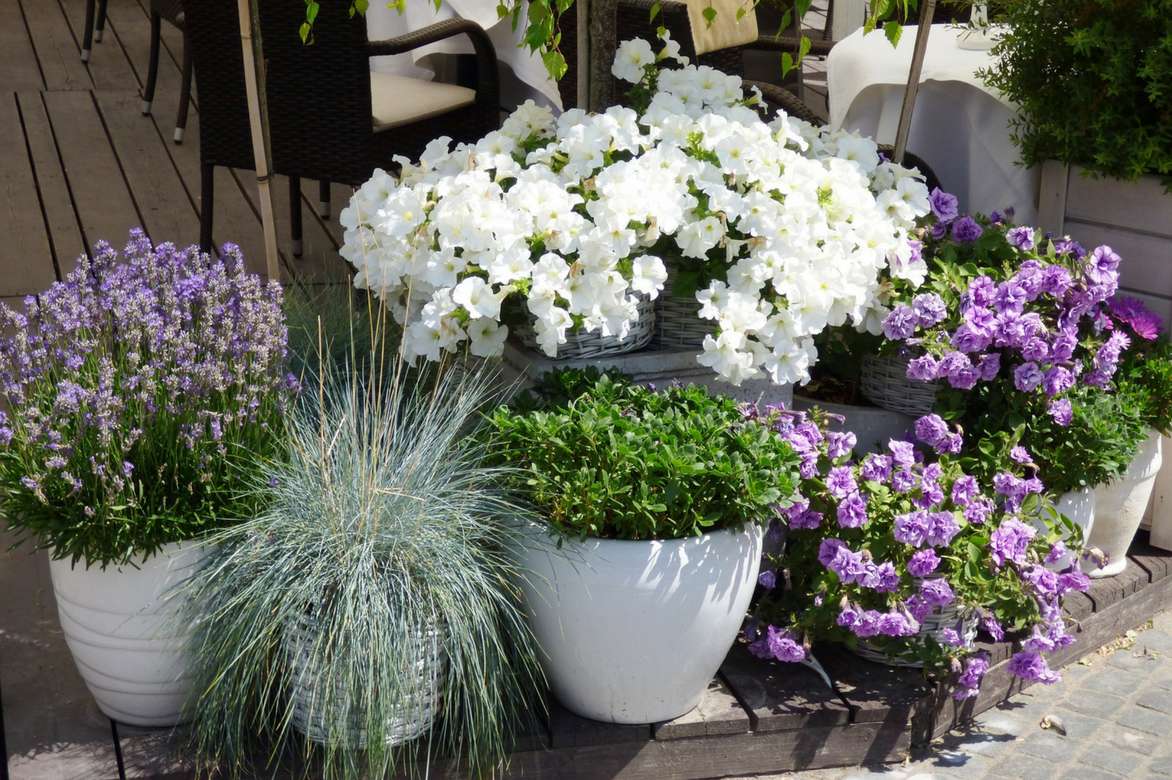
Lavender is well-suited for pot cultivation.
Finally, discover our article: How to Fail at Growing Lavender in 5 Lessons?
Read also
Pruning lavender: when and how?Care
Apart from annual pruning, Lavender requires limited maintenance. It is a young plant that is undemanding in water: once well established, it does not need watering.
⇒ More info: Pruning lavender: when and how?
Once well established in well-draining soil, lavender will become increasingly resistant to drought and will only require watering in cases of prolonged drought, when the soil is really very dry.
Water Lavandula stoechas or butterfly lavender with non-limestone water.
No fertiliser is needed for this undemanding plant.
For potted lavender, in case of an announced cold snap, it is better to wrap the aerial parts with a winter fleece. Bring the pot indoors before the first frosts, sheltered from the cold in regions north of the Loire. In winter, keep the substrate almost dry.
When and how to prune lavender?
Pruning lavender is essential; it helps maintain a lovely rounded and bushy shape for the plant, and it also encourages vigorous regrowth and abundant new flowering. Over time, lavender tends to become bare at the base, especially if it hasn’t been pruned each year.
An annual pruning with shears just after flowering is important to prevent it from becoming woody: the parts that lignify into hard wood gradually become bare and will no longer produce new shoots, which is why it is imperative to prune lavender beforehand! Pruning also helps to thin out the centre of the clump to prevent fungal diseases.
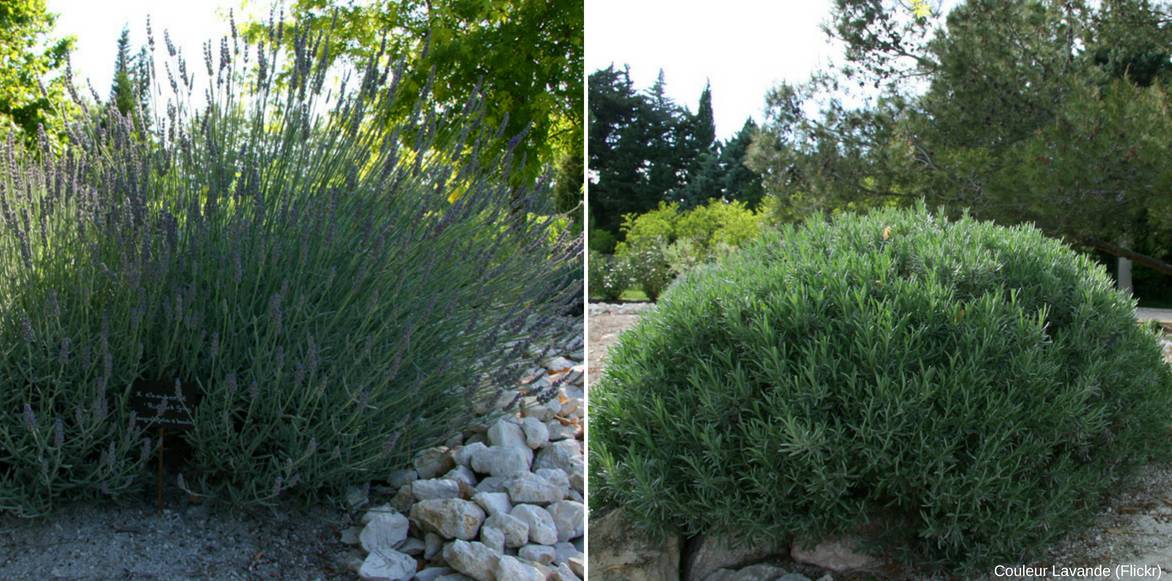
Prune lavender after flowering.
Be careful, lavender does not like overly severe pruning. If the plant is too bare at the base, simply consider renewing it. It is better to avoid intervening on an old lavender plant for fear of losing it. Pruning should only be done on this year’s wood, which is still green and tender and still has foliage: avoid touching the old wood, as it will not regrow, even from the stump.
Prune, from a young age, always after flowering at the end of summer or at the end of winter, using shears or hedge trimmers.
- Always prune above a leaf
- After flowering, cut the faded flower spikes back to their full length to avoid exhausting the plant unnecessarily: keep the deflowered inflorescences (dry them upside down) to make dried bouquets or scented sachets that will fragrance your linen
- Reduce the largest of the young shoots by 2/3 of their length (about ten centimetres) by cutting just above the first buds
- On older plants, prune all branches back by 10 cm
→ Also read our tutorial: How to rejuvenate an old lavender plant through pruning?
Diseases and potential pests
Cultivated under good conditions, a Lavender plant is rarely diseased. The main enemy of lavender is the stolbur phytoplasma, a bacterium usually transmitted by leafhoppers, particularly in crops: the plant wilts and becomes covered in honeydew (black droplets). To eliminate them: shower the foliage in the evening, cut, destroy the heavily infected plants. Wait 4 years before replanting in the same spot.
Lavender fears excess moisture which can suffocate its roots; it is a plant sensitive to cryptogamic diseases caused by the combination of heat and humidity and by waterlogged soil, which is why it is imperative to have very well-drained soil. In overly wet soil, it can sometimes fall victim to botrytis, a fungus that causes grey mould on the branches. As a preventive measure, prune every year to aerate the plant and spray with Bordeaux mixture.
In case of excess water in the soil, lavender is also threatened by armillaria or root rot, another fungus that resides under the bark and forms white patches leading to the plant’s death. There is no remedy: burn the plant.
Propagating: cutting and sowing of lavender
Lavender multiplies easily in summer by propagation by cuttings in July-August or by sowing in spring.
By propagation by cuttings
- At the end of summer, take a cutting just below a node from a semi-woody stem without flowers, already lignified, measuring 5 to 10 cm (that is, in the process of transitioning from softwood to hardwood)
- Remove the leaves from the lower third
- Plant them under a cold frame in a well-draining mixture of equal parts river sand and potting soil
- Keep the substrate moist until rooting, which takes about 6 weeks
- Transplant your cuttings into pots and protect your young plants from frost in winter
- Plant out in the following spring
- Pinch (cut) the tips to encourage bushier growth
- Water well during the first year after planting
To learn everything about propagating lavender, discover the illustrated tutorial by Virginie: “How to propagate lavender”
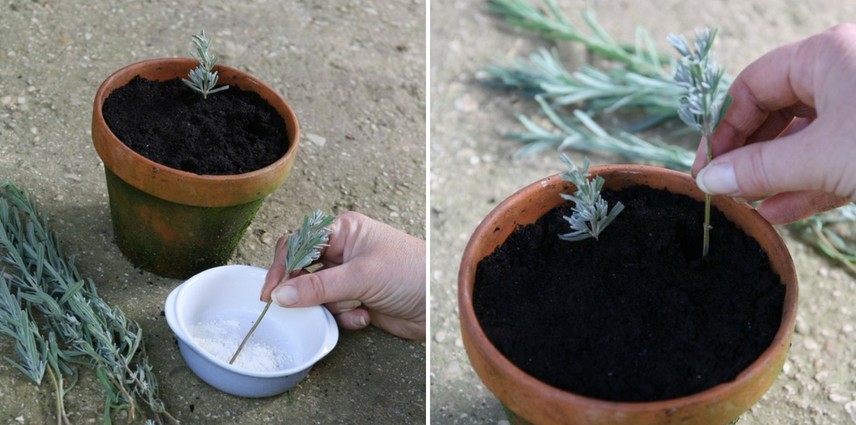
By sowing
Sow seeds from the previous year or obtain lavender seeds in packets. Germination can be slow.
- In spring, sow lavender in trays, pots, or buckets (4 or 5 seeds) in a well-draining seed compost
- Lightly cover the seeds with a bit of compost
- Place the sowing under a cold frame
- Keep the substrate moist throughout the germination period, which takes about 1 month
- When the seedlings reach 3 cm, thin them out, keeping only one per pot
- Transplant the young plants into 8 cm pots
- Allow them to grow under a cold frame, protected from frost and in light
- Water regularly but without excess
- Plant out in the ground in the following spring
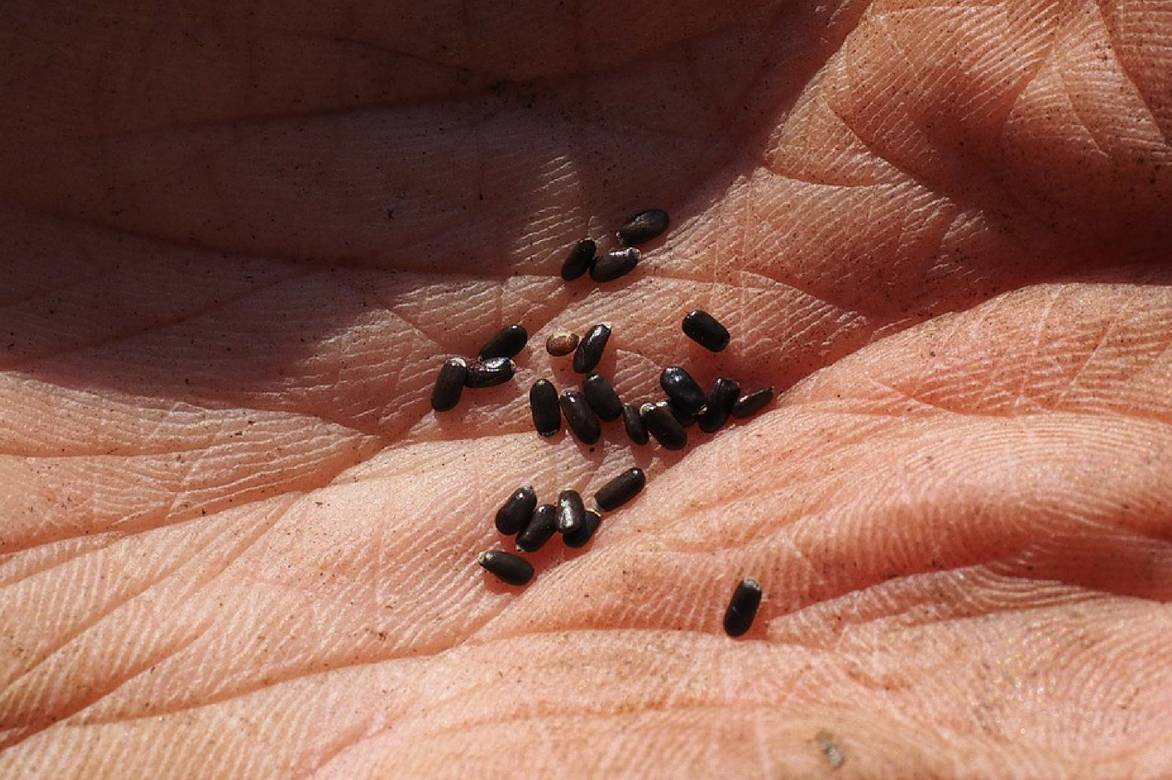
Lavender seeds.
Associating lavender in the garden
Through its graphic shape, floribundity, and silvery foliage, Lavender offers endless possibilities for gardeners. With its mauve, deep blue, violet, pink, or white bracts, lavender punctuates the landscape in a garden or in pots on a terrace.
It brings a refreshing yet refined Mediterranean touch to the garden and always adds character to a decor. It can be both classic or contemporary, vibrant or romantic.
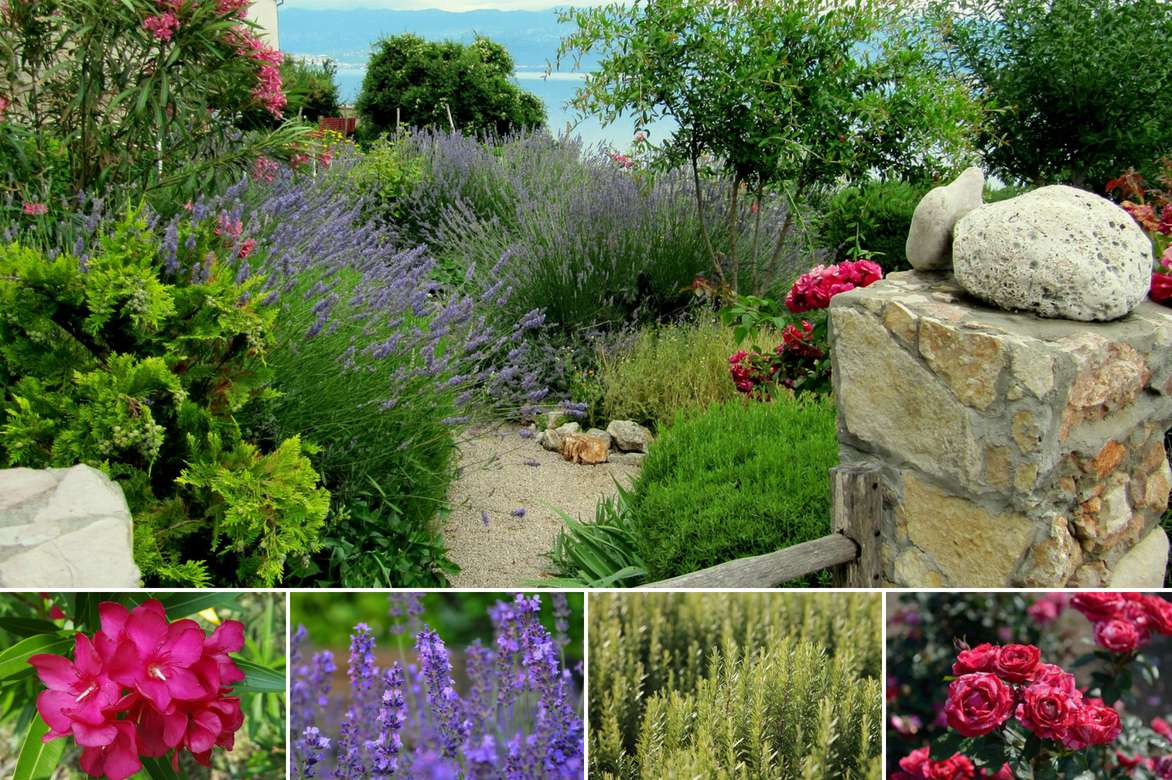
An example of association: Nerium oleander Red Single, Lavandula angustifolia ‘Hidcote’, Rosmarinus officinalis, Rose ‘Henri Matisse’.
Undisputed star of dry and sun-baked gardens, it is also an asset in a scree garden or rockery alongside Mediterranean perennial plants that are equally undemanding, such as santolines, some clumps of creeping rosemary, cistus, helianthemums, daylilies, wormwoods, and sedums.
In a modern garden, the spherical silhouette of its clumps will stand out in mineral scenes, punctuated by some small grasses like Stipa pennata or Stipa tenuifolia, which will contrast with their tousled and whimsical growth or with Phormium in an even more contemporary association.
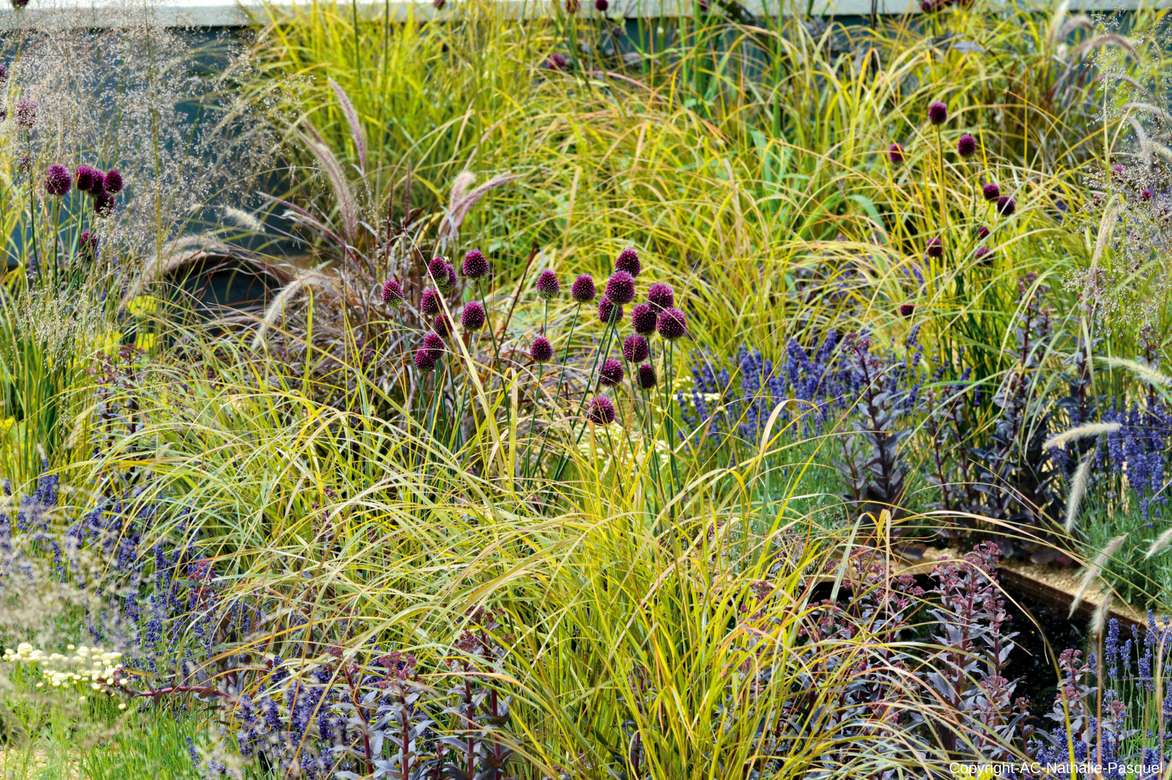
An idea for a contemporary association: Allium sphaerocephalon, Stipa arundinacea, Lavandula angustifolia ‘Hidcote’, Sedum ‘José Aubergine’.
With its somewhat untidy silhouette, it will create lush, colourful, and fragrant scenes in the heart of summer with very floriferous dryland perennials such as Gaura, Nepeta, Erigeron karvinskianus, Epilobium, Salvia, gaillardes, perennial flax, ornamental tobacco, and astragalus that will accompany its flowering throughout the summer.
On a dry slope, it can be planted with small dryland shrubs (Hertia cheirifolia, Hypericum olympicum) or at the foot of a beautiful olive tree.
The mauve spikes pair well with plants of the same hue, such as alliums, carnations, and hardy geraniums.
Its silver-tinted foliage and mauve bracts will have a striking effect when placed in front of dark shrubs like dwarf conifers, laurustinus, photinias, or will echo the deep blue or lilac offered by a ceanothus or a buddleia.
When the colours of the flowers harmonise, lavender and roses (‘Ballerina’) or bush roses often get along well in fresh and soft combinations.
In a chic and romantic version, lavender looks stunning with lilies or planted in alignment at the foot of climbing roses.
Its intense bluish colours can easily be paired with complementary colours like yellow from certain heleniums, echinaceas, Euphorbias, a Missouri evening primrose, or the large giant fennel in a tonic spirit, or the carmine or crimson of the flowers of an Hesperaloe parviflora, a dianthus deltoides, coreopsis, a Penstemon, an Oriental poppy, or a small potentilla.
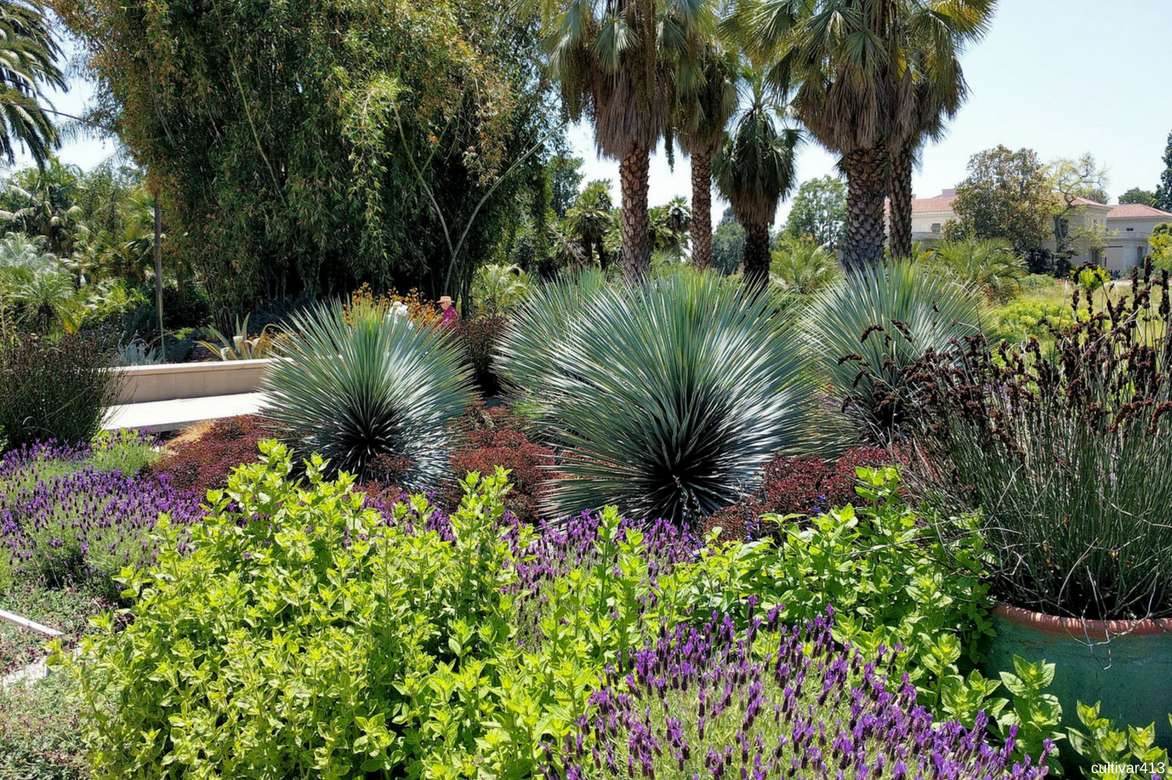
An example of an exotic association: Yucca rostrata, Chondropetalum tectorum, Origanum vulgare‘Aureum’, Lavandula stoechas.
Lavender easily pairs with cool colours and will be exceptional in the foreground of a flowerbed alongside the glaucous or grey tones of the foliage of an Artemisia or a Helichrysum italicum or ‘Curry Plant’.
It is also possible to create beds by mixing several varieties of lavender together, which will compose a tableau of beautiful persistent grey foliage, fluffy and elegant; even in winter, the rounded shape of lavender and its silver foliage will stand out.
Mix some aubrieta clumps and dianthus, for example, in a border of lavenders.
Useful resources
- Discover all our lavenders: we offer over 20 varieties!
- Explore the lavender routes! From Vercors to Verdon, in summer, the lavender fields are in flower!
- Advice sheet: 10 bushes with summer flowering that you must have in your garden
- Advice sheet: How to dry lavender?
- Advice sheet: Lavender: which one to choose?
- Advice sheet: our ideas to combine lavender in the garden
- Illustrated tutorial: How to propagate lavender?
- Our tutorial: How to prepare lavender manure?
- Advice sheet: 5 repellent plants to keep wasps away
- Advice sheet: Lavenders, the sure values
- Advice sheet: Lavenders, the most beautiful varieties, Lavender: the most beautiful white varieties
- Advice sheet: Lavender: the best varieties for pots
- Advice sheet: Lavender, the most beautiful varieties with purple flowers
- Discover How to create a lavender garden?
- Our illustrated tutorials: How to make lavender syrup?, How to make lavender herbal tea?, Forming a lavender on a stem, How to make lavender vinegar?
Frequently asked questions
-
Should lavender be pruned?
Yes, the earlier you prune, the better your lavenders will age! Pruning helps to maintain a bushy and compact habit for lavender, and it will be less likely to become bare at the base: the plant will ramify more and more to remain highly floriferous. Prune after flowering or in autumn, reducing all young shoots by two-thirds.
- Subscribe!
- Contents
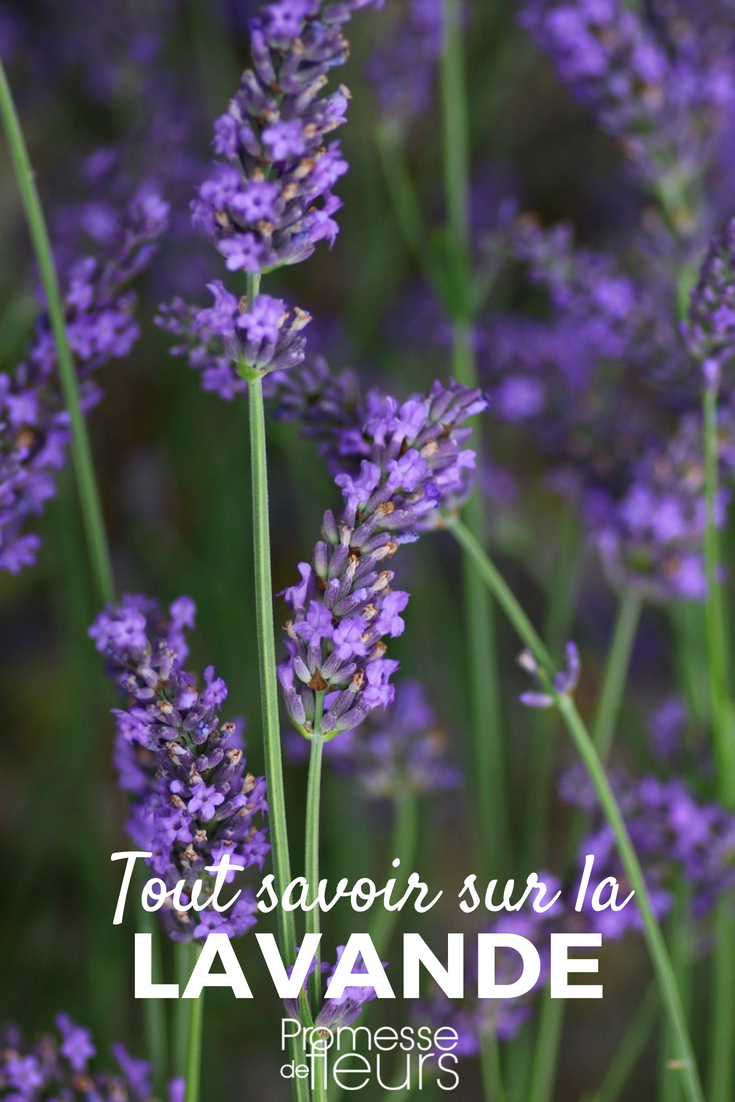































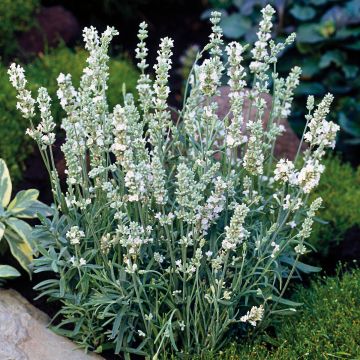
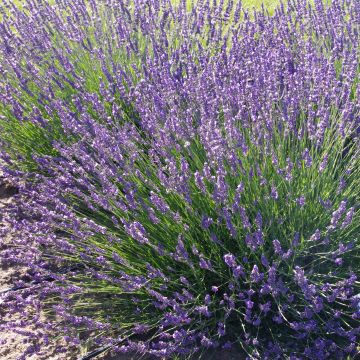

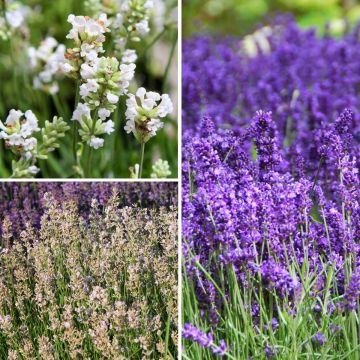
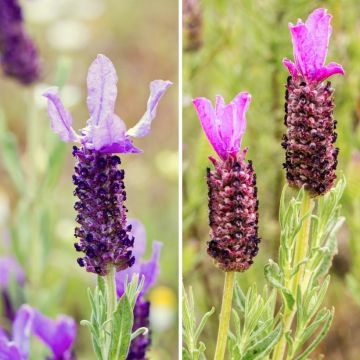
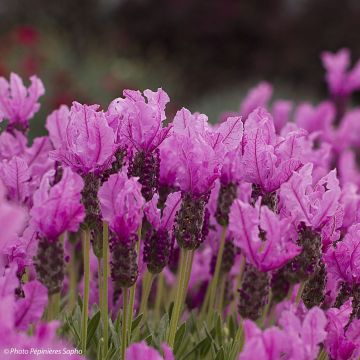

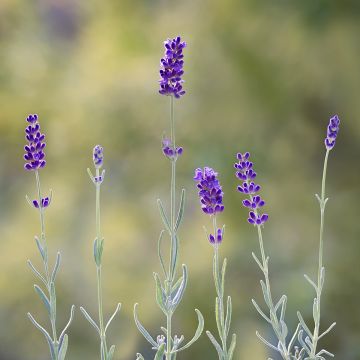


Comments